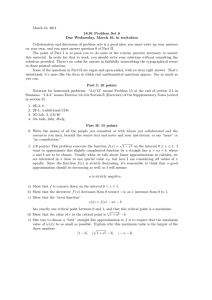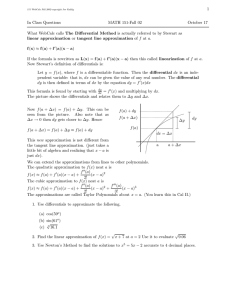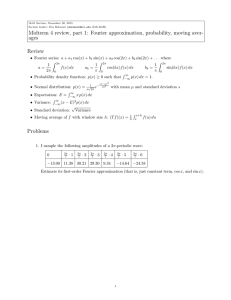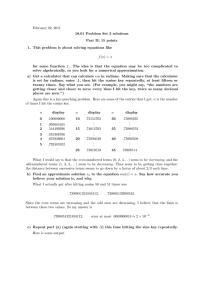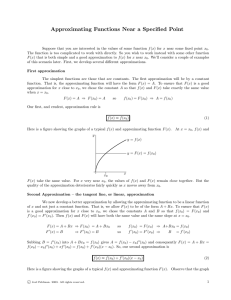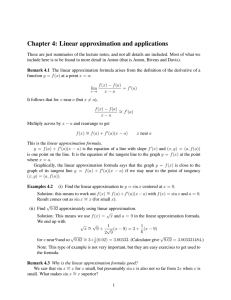1 In Class Questions MATH 151-Fall 02 October 17
advertisement
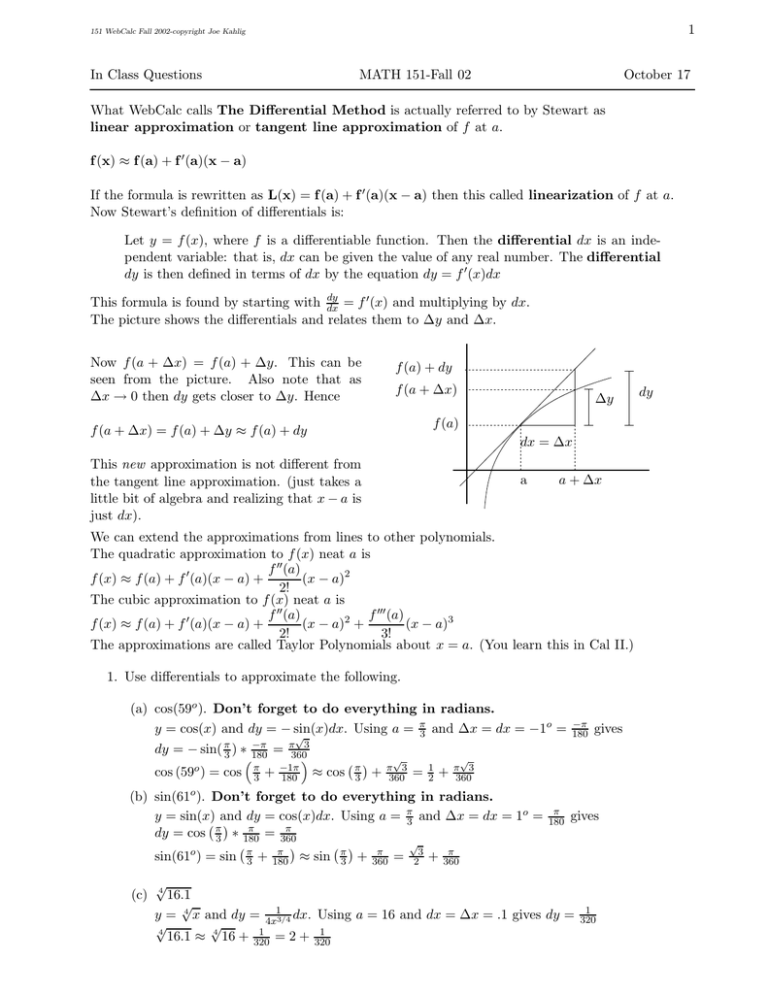
1 151 WebCalc Fall 2002-copyright Joe Kahlig In Class Questions MATH 151-Fall 02 October 17 What WebCalc calls The Differential Method is actually referred to by Stewart as linear approximation or tangent line approximation of f at a. f (x) ≈ f (a) + f 0 (a)(x − a) If the formula is rewritten as L(x) = f (a) + f 0 (a)(x − a) then this called linearization of f at a. Now Stewart’s definition of differentials is: Let y = f (x), where f is a differentiable function. Then the differential dx is an independent variable: that is, dx can be given the value of any real number. The differential dy is then defined in terms of dx by the equation dy = f 0 (x)dx dy This formula is found by starting with dx = f 0 (x) and multiplying by dx. The picture shows the differentials and relates them to ∆y and ∆x. Now f (a + ∆x) = f (a) + ∆y. This can be seen from the picture. Also note that as ∆x → 0 then dy gets closer to ∆y. Hence f (a) + dy f (a + ∆x) ∆y f (a) f (a + ∆x) = f (a) + ∆y ≈ f (a) + dy dx = ∆x This new approximation is not different from the tangent line approximation. (just takes a little bit of algebra and realizing that x − a is just dx). a a + ∆x We can extend the approximations from lines to other polynomials. The quadratic approximation to f (x) neat a is f 00 (a) f (x) ≈ f (a) + f 0 (a)(x − a) + (x − a)2 2! The cubic approximation to f (x) neat a is f 00 (a) f 000 (a) f (x) ≈ f (a) + f 0 (a)(x − a) + (x − a)2 + (x − a)3 2! 3! The approximations are called Taylor Polynomials about x = a. (You learn this in Cal II.) 1. Use differentials to approximate the following. (a) cos(59o ). Don’t forget to do everything in radians. y = cos(x) and dy = − sin(x)dx. Using a = π3 and ∆x = dx = −1o = √ −π dy = − sin( π3 ) ∗ 180 = π3603 cos (59o ) = cos π 3 + −1π 180 π 3 ≈ cos + √ π 3 360 = 1 2 + (c) π 3 + π 180 ≈ sin π 3 + π 360 = √ 3 2 + gives √ π 3 360 (b) sin(61o ). Don’t forget to do everything in radians. y = sin(x) and dy = cos(x)dx. Using a = π3 and ∆x = dx = 1o = π π π dy = cos 3 ∗ 180 = 360 sin(61o ) = sin −π 180 π 180 gives π 360 √ 4 16.1 √ y = 4 x and dy = 4x13/4 dx. Using a = 16 and dx = ∆x = .1 gives dy = √ √ 4 1 1 16.1 ≈ 4 16 + 320 = 2 + 320 1 320 dy 2 151 WebCalc Fall 2002-copyright Joe Kahlig 2. Find the linear approximation of f (x) = √ √ x + 7 at a = 2 Use it to evaluate 9.06 The equation of the tangent line for f (x) at a = 2 is y − f (2) = f 0 (2)(x − 2) y − 3 = 16 (x − 2) y = 83 + x6 so the linear approximation is L(x) = Since 8 3 + x 6 √ √ √ 9.06 = 2.06 + 7, we need to compute L(2.06) to find the approximation of 9.06. L(2.06) = 8 3 + 2.06 6 3. Use Newton’s Method to find the solutions to x5 = 5x − 2 accurate to 4 decimal places. f (x) = x5 − 5x + 2 and f 0 (x) = 5x4 − 5. An+1 = An − a5n −5An +2 5A4n −5 There are three solutions for this formula. x = 1.3718 x = 0.4021 x = −1.5820


